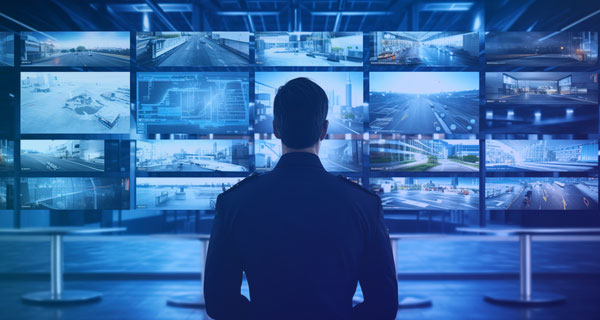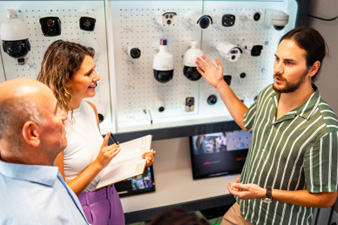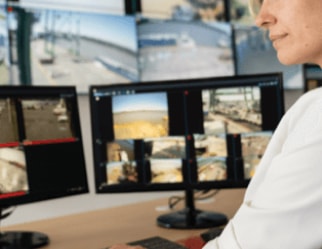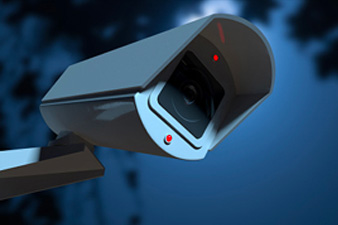Choosing the right monitor for your commercial customers can be challenging due to the many options and the fact that the technology behind them is changing at a rapid pace. This guide will walk you through the different types of monitors and their features, enabling you to choose the right one for your customers.
Screen mode helps determine the appropriate resolution for displaying content. Opting for the correct screen mode ensures content matches the display's capabilities, resulting in sharp, accurately proportioned visuals. This knowledge forms the foundation for delivering high-quality presentations and media experiences in professional audio-visual installations.
Keep in mind that screen size today is determined by a diagonal measurement of the monitor. A simple calculation will do the trick to find the right screen size for your customer. First, measure the distance between where the monitor will be and where you plan to view the monitor. Divide the total distance in inches by two and the resulting number will be the minimum diagonal measurement of the monitor you should choose for your customer.
Bracket mounts attach to the back of a monitor and provide a mounting point for a monitor arm or other type of mount. They are typically used with monitors that do not have built-in VESA mounting holes.
VESA mounts are a standardized mounting system for LCD and LED monitors and are available in a variety of sizes and patterns, so it is important to choose a mount that is compatible with your monitor.
Monitors can also be mounted to desks, walls, or ceilings. Desktop mounts attach to the edge of a desk or table and allow you to adjust the height, tilt, and swivel of your monitor. Wall mounts allow you to mount your monitor flush against the wall to save space or create a more streamlined look. Ceiling mounts allow you to suspend your monitor overhead, which is a good option for standing desks or creating a more immersive viewing experience.
Refresh rate refers to the number of images that flash on the monitor screen per second. Refresh rates are expressed in hertz, so a refresh rate of 75 Hz means the image is refreshed 75 times in a second. The higher the refresh rate, the smoother the picture and reduced blurriness.
The aspect ratio of a monitor is highly relevant as it directly affects the display's shape and how content is presented. The aspect ratio is the ratio of the width to the height of the screen The choice of aspect ratio depends on the intended use of the monitor. Examples of use:
4:3 - Digital signage, medical imaging, older televisions and computer monitors
16:9 - Most modern televisions and computer monitors, movies, TV shows, and video games
16:10 - Professional monitors, laptops
Backlit technology in monitors plays a pivotal role in enhancing display quality. There are primarily two types: Direct LED and Edge LED.
Direct LED, also known as LED (Light Emitting Diode), involves placing an array of LEDs directly behind the screen. This configuration allows for precise local dimming, resulting in superior contrast and black levels.
On the other hand, Edge LED positions LEDs along the edges of the screen. While it's more energy-efficient and enables slimmer designs, it may have limitations in uniformity and contrast compared to Direct LED.
WLED (White LED) is a common backlighting source, utilising blue LEDs with a phosphor coating to produce white light. It offers efficiency and longevity, contributing to the vibrant visuals we expect from modern monitors. Shop by Backlit Technology
LCD (Liquid Crystal Display) and LED (Light Emitting Diode) are common monitor technologies. LCDs use liquid crystals to manipulate light, while LEDs use semiconductor diodes for backlighting. LED monitors are generally more energy-efficient and offer better contrast and brightness. LCDs are still prevalent but often in older models, while LED dominates the market due to superior performance.
LCD monitors are commonly used in educational settings, healthcare, Point of Sale (POS) Systems, digital signage, public transportation, security and surveillance, and air traffic control. LED monitors are used in a wide array of applications, owing to their energy efficiency and superior performance. They are typically found in digital billboards and signage, outdoor sports stadiums, airport information displays and retail displays.
ADI offers you a number of value-added services to help with all of your AV installation projects.
ADI's site survey experts will assist you on-site to understand your customer’s needs, assess site feasibility and achieve the best solution in terms of design and budget.
Let our product specialists demonstrate the latest technology, product features and customer benefits either face-to-face or in an interactive environment.
Sign up for a webinar, attend a branch event or stop by an ADI Expo near you to gain industry knowledge and learn about new products and solutions.
We aim to provide effective problem resolution while reducing time spent on-site as much as possible. Our experts can troubleshoot issues virtually or on-site.
ADI’s system design service can help with any project, designing a system that is specifically fit for your project requirements — at the best possible cost.
Read our latest articles and explore additional solutions and guides for installers and dealers

This guide will walk you through the different types of display screens and their features, enabling you to choose the right one for your customers.

A video surveillance system is essential for any business, big or small. Choosing the right system, however, can be a challenge when you're trying to customise the installation to your customer's specific needs. Our security camera buying guide can help you find the appropriate IP cameras, recording device and video storage option to meet your project's specifications.

Learn how the Axis end-to-end offering provides a security solution beyond just video, opening the door to more profitable project.

Learn how to streamline your control room operations with Planar's visualisation and footage analysis solutions.

Join our webinar and learn more about commercial and residential video surveillance solutions for challenging lighting conditions.

Whether your project is big or small, ADI can meet all of your Pro AV needs. With top-quality products from more than 50 leading brands, we offer more brands, more inventory, more support and more services.

Installers and integrators who need help designing solutions that save time on site, reduce overall costs, minimise risk and enhance end-user satisfaction could benefit from project support services.